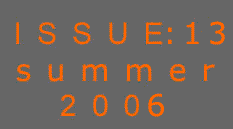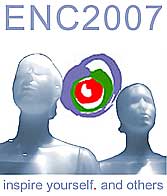
MEPs’ fact-finding mission to Gorleben
On 8 June 2006, a cross-party group of 12 MEPs
and two MEP assistants, accompanied by senior officials of the
Regional Government of Lower Saxony, nuclear industry representatives
and a 7-strong party from FORATOM, visited the GNS (Gesellschaft
für Nuklear Service) facilities at Gorleben, Germany.

from left to right: Dr. R. Linkohr (TREN), E. Herczog
(MEP), A. Vidal-Quadras (MEP), P. Uhlmann (E.ON), C. Eberl (Staatssekretär)
The Competence Centre for Nuclear Waste Disposal
facilities at Gorleben (the site was selected by Germany’s
Federal Government from among 26 proposed locations) is one of
four GNS sites in Europe – the others being at Plzen (Czech
Republic) and Creys-Malville and Maubeuge (both in France). GNS
is a joint venture involving four shareholding companies that
participate financially in the enterprise: E-ON (48%); RWE (28%),
SNE (Süwestdeutsche Nuklear-Entsorgungsgesellschaft mbH -18.5%)
and Vattenfall (5.5%). GNS has four subsidiary companies that
it partially or totally owns: BLG (Brennelementlager Gorleben
GmbH) and BLZ (Brennelement Zwischenlager Ahaus) are specialised
in the storage of spent fuel rods and high-active waste and have
operations in Gorleben and Ahaus respectively; WTI (Wissenschaftlich
Technische Ingeieurberatung GmbH) that provides technical expertise
and consultancy services in the field of engineering and DBE (Deutsche
Gesellschaft zum Bau und Betrieb von Endlagern für Abfallstoffe),
which is specialised in the construction of storage facilities
for radioactive waste and is the major partner in the salt mine
operations.
Historical overview
Before visiting the facilities, the visitors
were given a detailed overview of the history of spent fuel and
radioactive waste management in Germany and of the Gorleben project.
The political developments – at local, regional, national
and international levels - that have shaped Gorleben’s history
since it was first developed were of particular

A. Vidal-Quadras (MEP)
|
interest to the MEPs and
their assistants. In Germany, although the nuclear industry
is responsible for the transport, interim storage, reprocessing
and preparation for final disposal of spent nuclear fuels,
it is the Federal Government that is responsible for the
exploration, construction and operation of a final repository.
However, it is the German nuclear industry that has to finance
the exploration, construction and operation part of the
equation.
The Gorleben facilities were originally
intended to house a reprocessing site for spent nuclear
fuel, an interim storage facility, a pilot conditioning
plant and a site for a final repository for radioactive
waste – in the Gorleben salt dome. However, in 1979,
the plans to build the reprocessing plant at Gorleben were
shelved for political reasons. A project to build a reprocessing
plant in Wackersdorf (Bavaria) was also abandoned and all
spent fuel produced in Germany was to be sent to La Hague
(France) and Sellafield (UK). |
Red-green coalition imposes moratorium
Chancellor Schroeder’s “red-green”
coalition came to power in 1998. The new, essentially anti-nuclear
government replaced the concept of a centralised interim storage
facility with that of decentralised interim storage units at every
nuclear power plant. This was done in order to avoid the problem
of transporting spent nuclear fuel within Germany, which had become
a much publicised cause célèbre among green activists
bent on stoking up anti-nuclear public opinion. Instead, all high
active waste from the reprocessing plants abroad was to be shipped
to Gorleben.
|
In 2000, the German Government then suspended all the exploratory
work going on into a deep geological final repository at
the Gorleben salt dome, declaring a moratorium for a period
of between 3 and 10 years (it is due to continue to 2010).
The objective of the moratorium was to give all parties
the chance to “clarify open questions” regarding
a final repository. Although all those questions had been
answered by the end of 2005, and the viability of a final
repository 800m below ground in the Gorleben had been proven
beyond all reasonable doubt, the moratorium has remained
in place – for ostensibly political reasons. In fact
a detailed assessment of the facilities, which was confirmed
by the Federal Government, found absolutely no grounds whatsoever
to suggest that Gorleben is not an ideal location. Consequently,
the consensus view is that is no need to search for an alternative
site somewhere else in Germany. |

Staatssekretär C. Eberl
|
Experimental work goes ahead
In spite of the moratorium, experimental work
into conditioning and interim storage stills continues at Gorleben,
albeit it on a smaller scale than before. There are already around
68 special casks (called CASTOR containers) containing vitrified
high active radioactive waste housed in the transport container
area of the GNS interim storage facilities and another shipment
is due to be stored there later in the year. Each cask satisfies
the strict safety standards imposed by IAEA and controlled by
EURATOM. There is room for a great deal more containers before
the maximum capacity of 420 is reached.
Further experiments and geological work is still
being carried in Gorleben by DBE in the miles of underground galleries
in the salt dome. This work has further confirmed that salt is
an ideal repository medium for spent fuel and vitrified high active
waste.
As far as the separate issue of reprocessing
is concerned, since the German Nuclear Power Act (“Atomgesetz”)
came into effect in July 2005, it has been banned at all German
power plants and spent fuel now has to be directly disposed of
in a final repository after being stored in the interim storage
facility and conditioned.
Visit and Workshop
After arriving at Gorleben the visitors listened
to introductory remarks from Prof. Dr. Hartkopf, a member of the
Managing Board of EnBW; Dr. Hans-Heinrich Sander, Environment
Minister in the Regional Government of Lower Saxony; Dr. Peter
Haug, Director General of FORATOM and Dr. Kleeman of BFS (Germany’s
Federal Office for Radiation Protection).
The tour of the facilities proper began with
a visit to the pilot conditioning plant and the interim storage
facilities for spent fuel and high-active waste, as well as for
low and medium active waste.
After the tour was over, participants took part
in a Workshop entitled Waste Management at Gorleben, Myth and
Reality, which was organised by FORATOM. During the Workshop participants,
especially the MEPs present, gave their views on some of the important
political issues at stake. Ute Blohm-Hieber (Head of Unit, Nuclear
Energy, DG TREN, European Commission) and Simon Webster (Head
of Unit, Nuclear Fission and Radiation Protection, DG Science
and Research, European Commission) then gave presentations on
EU nuclear energy and research policy. Dr. Bruno Thomauske, Managing
Director of Vatenfall Europe Nuclear Energy then exposed some
of the myths surrounding Gorleben and gave an update of the current
state of affairs. Finally, Dr. Christian Eberl, Secretary of State
at the Environment Ministry of the Regional Government of Lower
Saxony gave a political appraisal from a Regional Government perspective.
After the Workshop, a lively dinner debate followed
during which MEPs from all sides of the political spectrum –
including a Green Party MEP – questioned the speakers and
exchanged views with the other participants.
 from
left to right: Dr. P. Haug (Foratom), K.-D. Grill ex MdB,
Dr. M. Flachsbarth MdB
from
left to right: Dr. P. Haug (Foratom), K.-D. Grill ex MdB,
Dr. M. Flachsbarth MdB |
 Ute
Blohm-Hieber,
Ute
Blohm-Hieber,
(EC TREN ) |
Raising awareness, applying political pressure
The objective of this fact-finding mission was
to sensitise European politicians to the state-of-the-art work
that GNS is carrying out at Gorleben and to the effective solutions
that it offers with regard to the conditioning, interim storage
and long-term geological storage of high active waste and spent
fuel. Hopefully, visits of this kind will help raise awareness
among national and European politicians of the assets of the Gorleben
facility. Hopefully, they will help to accelerate the whole nuclear
debate in Germany and publicise the economic, social and environmental
aspects of the work that is being carried out at Gorleben. Above
all, they can help put pressure on the Federal Government in Germany
to lift the current moratorium on the Gorleben operations and
to kick start Germany’s dormant radioactive waste management
and storage programme. Time will tell.
One fact that was obvious was that Gorleben could
quite easily be made “fully operational” and that
assuming that exploration was resumed quickly, final storage in
the salt dome could be a reality by 2025.
|










